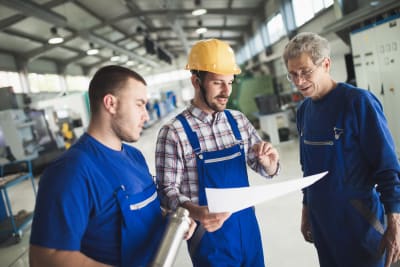Every industry has a group of professionals who are always at the forefront of public admiration, enjoying constant praise for what they do, and another group who work tirelessly behind the scenes to ensure that the whole industry runs smoothly. Aircraft mechanics belong to the latter.
An aircraft mechanic is responsible for ensuring that aircraft are in the perfect shape required for successful flights. Through rigorous inspections, testing, and repairs, aircraft mechanics play their part in guaranteeing millions of people’s safety every day.
But how exactly do they go about their duties? What are the peculiarities involved? How do you become one, and how much can you expect to earn for your efforts? We answer all of these questions and more below.
Who is an Aircraft Mechanic?
Aircraft mechanics are professionals in the aviation industry who have undergone years of training to carry out maintenance and safety checks on aircraft. Aircraft mechanics, sometimes known as aviation technicians, are called upon whenever an aircraft needs inspection or repairs.
They are trusted to use their expertise to determine if an aircraft is in good shape to fly. If not, they will either recommend that the plane be grounded until it’s ready or carry out the necessary repair and maintenance duty to ensure the aircraft is prepared the next time it’s called upon.
An Airframe certification is enough to start practicing, but it is more common for an aircraft mechanic to possess both airframe and powerplant certification (A&P). At this point, they are referred to as airframe and powerplant mechanics.
Roles and Responsibilities of an Aircraft Mechanic
Among other things, aircraft mechanics supervise and manage the maintenance-related aspects of aircraft. In carrying out their duties, you’ll often find aircraft mechanics engaged in the following tasks:
- Inspecting aircraft to detect issues, either severe or mild
- Repairing aircraft to ensure it is in the best shape for flight
- Maintaining critical parts to ensure longevity and smooth running
- Keeping accurate records and log books as specified by the FAA
- Organizing inventory of tools and components for the hangar
What to Expect on the Job
A career as an aircraft mechanic can be a physically demanding one. Naturally, you will often have the fate of many people resting on your judgment; years of rigorous mechanical training are required even to get started on the job.
While on the job, you must also prioritize meticulousness and perfection, as there is no room for error. Additionally, you should be prepared to function at a high level, even in a fast-paced environment. Aircraft mechanics often live in big cities, so relocation is always possible.
Lastly, an aircraft mechanic must be committed to continual study and improvement. They must keep learning about complex engines and systems that are continually upgraded, and they must stay caught up.
Becoming an Aircraft Mechanic
Becoming an aircraft mechanic involves acquiring specialized skills and certification. Below is the most recommended pathway to achieve this goal.
Step 1: Meet Eligibility Requirements
Individuals who wish to become aircraft mechanics must obtain proper training from a recognized institution and become certified. To do so, they must first meet some eligibility requirements. The first is the age requirement, which dictates that applicants must be at least 18 years old.
Additionally, they must be able to speak, read, and write English proficiently, partly because they will also have to take and pass a required test in a space of 24 months.
Step 2: Choosing a Specialty
While aircraft mechanics are generally designated as such when starting, there are additional specialties dealing with different areas of aviation maintenance that an aircraft mechanic may choose. These include the primary aircraft mechanic designation, which covers entry-level technical roles; the airframe and powerplant (A&P) mechanics appointment for aircraft mechanics who have become certified and can supervise other technicians; along with the avionics technician designation for those who deal with navigation equipment, autopilot systems, radio, and entertainment systems among others.
Aircraft mechanics may also specialize as Inspection Authorized (IA) mechanics, directing maintenance and conducting annual aircraft maintenance as specified by the FAA and aviation investigators employed by the NTSB (National Transportation Safety Board) to investigate aircraft incidents.
Step 3: Acquire Appropriate Education
Aspiring aviation mechanics don’t have to obtain a college degree before being allowed to practice. A training program at an aircraft maintenance technician school (AMTS) is usually enough.
These training programs tend to last for at least 18 months, and more than anything, they must be accredited by the FAA to be legitimate.
Students who wish to earn an associate’s or bachelor’s degree to increase their employment potential may also choose to do so.
Step 4: Apprenticeship and On-the-job Training
College degrees or training programs are not the only ways to become aircraft mechanics. It is also possible to acquire on-the-job training through an apprenticeship program. This is great as it allows you to experience real-world scenarios and perform tasks such as performing routine maintenance and inspecting basic systems.
Step 5: Certification
To begin practicing as an aircraft mechanic, you must be certified by the FAA. To do so, you must meet the eligibility requirements above and attend a training school approved by the FAA. In place of the training, you may possess 30 months or more of airframe and powerplant experience.
Aircraft Mechanic Salary and Career Overview
According to the Bureau of Labor Statistics, aircraft mechanics earned a median annual wage of $65,380 in 2021. Those who fell in the bottom ten percent of earners took home about $38,270, while those in the top ten percent earned as much as $98,590.
Those who worked in scheduled air transportation took home the highest average salary by specialization at $96,320. Aerospace product and part manufacturing mechanics, along with those who worked for the federal government, followed with an annual salary of $64,900 and $64,710, respectively.
As for the career outlook, the field is expected to grow 6 percent between 2021 and 2031. The reasons cited for this projection include replacing aging workers and increasing air traffic.





